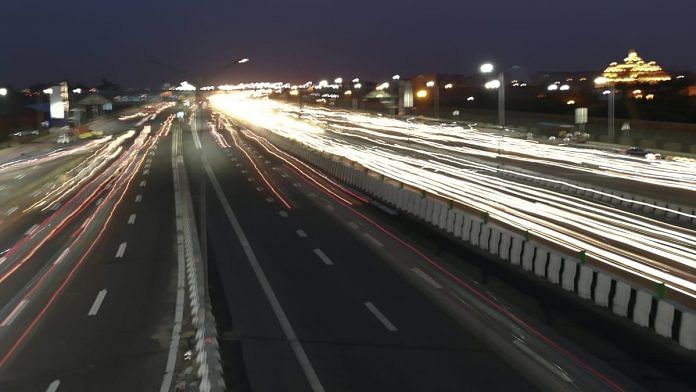New Delhi: On 11 December, Prime Minister Narendra Modi inaugurated Goa’s Mopa International Airport, 12 years after the then Congress-led United Progressive Alliance (UPA) government had approved the project.
For years, the airport project had languished owing to land acquisition issues and political differences, but in 2016, Goa’s BJP government tasked the infrastructure company GMR Group to build it on a public-private-partnership model.
This, though, is not the first big-ticket infrastructure project that was pending under UPA, (or even previous governments for that matter), but completed after the National Democratic Alliance (NDA) came to power at the Centre in 2014.
Since he took charge as Prime Minister, Modi has on several occasions spoken of how the UPA government left projects incomplete during its tenure. He has also emphasised that many delayed infrastructure projects have been taken up, fast-tracked, and completed since 2014.
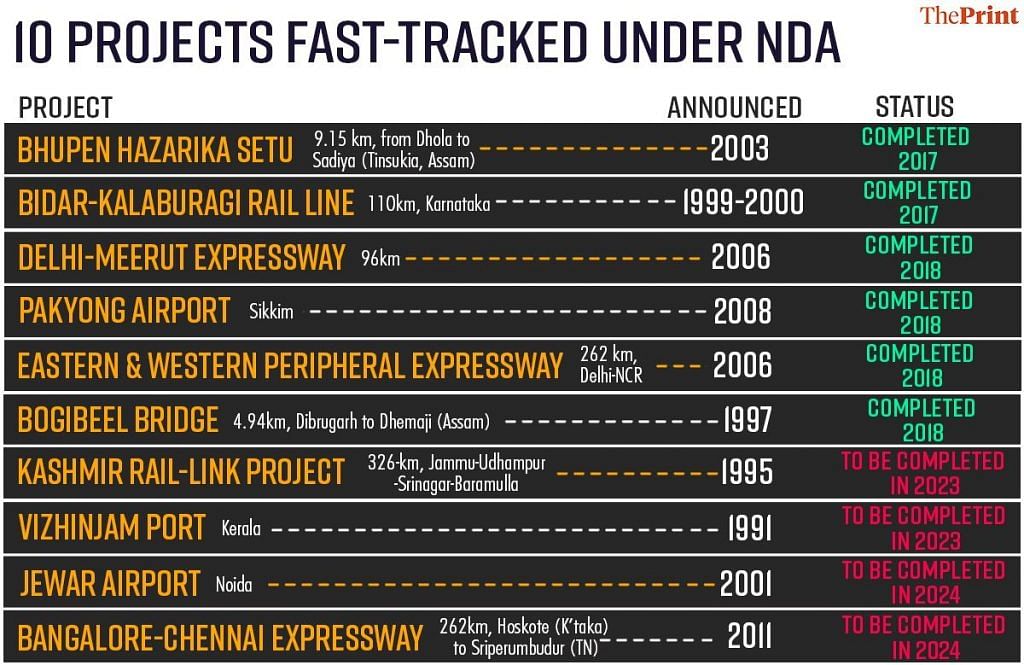
For instance, when he inaugurated the Rs 9,900-crore Saryu irrigation project in Uttar Pradesh last December — 40 years after it had been conceptualised — the PM slammed previous state governments for “delaying projects” and “wasting public money”.
Infrastructure experts who spoke to ThePrint agreed that stalled projects came at a heavy cost.
“The biggest problem of stalled projects appeared in the last two-three years of the UPA government — from 2011 to 2014,” said Vinayak Chatterjee, chairman of the infrastructure consultancy firm Feedback Ventures. In this period, he pointed out, infra projects worth an estimated Rs 18 lakh crore were stalled.
The UPA did take some action at this point, Chatterjee added. In 2013, the Manmohan Singh government created a special project monitoring group (PMG) in the cabinet secretariat, spearheaded by IAS officer Anil Swarup, to expedite stalled infra initiatives.
The PMG, said Chatterjee, established various systems to unlock issues that had led to projects being stuck and promoted collaboration between central ministries and state governments.
But while the PMG under the UPA was able to get projects worth Rs 7-8 lakh crore moving, bigger changes took place post-2014, with a more focused and multi-pronged review system, he added.
The opposition Congress, which led the UPA from 2004 till 2014 has, however, said that the Modi government cannot cherry-pick a handful of projects and claim that the NDA completed what the UPA started.
“There were many projects that Vajpayeeji started, but the UPA completed and we are happy to give credit,” said Praveen Chakravarty, chairman of Congress’s data analytics wing.
Also read: How Arunachal is front & centre in Modi govt’s massive border infra push to counter China
Four-sided push
Under the Modi government, stalled projects have been receiving an impetus from four primary fronts, according to Chatterjee.
The first, he said, is the Ministry of Programme Implementation and Statistics, which calculates the value of delayed projects and their cost overruns.
Then, he added, there is the Pro-Active Governance And Timely Implementation programme, or PRAGATI, which was set up in 2015 with the aim of removing bottlenecks in centre-state projects.
At PRAGATI meetings, the PM talks directly with stakeholders about issues related to infra projects. As of May this year, 40 such meetings had taken place.
The third, Chatterjee said, is the PMG, which has continued from when the UPA introduced it and is now housed under the commerce ministry.
And, finally there is Niti Aayog, the government’s public policy think tank. According to Chatterjee, it not only helps lay out targets to execute big-ticket projects, but also ascertains which ones are more prudent to abandon.
As of November this year, Rs 1.26 lakh crore worth of projects reportedly came under the latter category.
“There is a very concerted push to deal with the conditions that are impeding projects. I personally am very happy with the focus on getting projects to move,” Chatterjee said.
But according to Chakravarty, the Modi government should share some of the credit.
“I think the PM should say thank you for conceiving the project just as we are very happy to thank Vajpayeeji for conceiving the golden quadrilateral, which we expanded and I will acknowledge, the Modi government is further expanding,” Chakravarty said.
The UPA also racked up some major successes, he added.
“It’s actually in the 10 years of UPA that everything from the telecom sector to the power sector to the airport sector — all capital-intensive infrastructure projects — actually gained rapid momentum,” Chakravarty said. “Let’s not forget how many airports were conceived, ideated, built and opened in the UPA period. The UPA government was able to complete brand new Delhi, Mumbai, Chennai, Kolkata airports, which is no small feat.”
Nevertheless, several major infra projects that were delayed during the UPA era have been completed or fast-tracked since 2014.
Roads to rail, airports to port
Has the Modi government put its money where its mouth is when it comes to seeing through delayed infra projects?
ThePrint has compiled a list of 10 big-ticket infra projects that were mired in delays during the UPA period, and some even before that, but which have either finally been completed or have been on the fast track to completion since 2014.
The list below has been organised chronologically, based on the date of completion/anticipated completion. All expenditure figures and estimates have been taken from government data.
1. Bhupen Hazarika Setu
Built over the Lohit River, a tributary of the Brahmaputra, the 9.15-km-long, three-laned bridge connects Dhola and Sadiya villages in Assam’s Tinsukia district. The latter is close to the border with Arunachal Pradesh, which means that the bridge has brought down travel time between the two states from six hours to just one.
The Rs 2,056-crore bridge, touted as India’s longest bridge over water, was inaugurated in May 2017 and has given a big boost to connectivity in the region. Before it came up, residents relied on a ferry to cross the Brahmaputra at this stretch.
Named Bhupen Hazarika Setu after the famous Assamese singer, the bridge first came into discussion in 2003 when a local MLA called Jagadish Bhuyan (who has since joined the BJP) wrote to the then PM Atal Bihari Vajpayee about the importance of building the bridge.
The proposal was formalised, but work stagnated during the UPA regime, resulting in the long gestation period before the bridge was finally completed.
2. Bidar-Kalaburagi rail line
The 110-km rail link connecting Karnataka’s Bidar and Kalaburagi was proposed way back in 1999-2000 when Atal Bihari Vajpayee was the PM.
For the next 16 years, the project slowed to a crawl due to one issue or another. Land acquisition and budgetary issues got some of the blame, but lack of political will was also seen as a factor in the delay.
The Rs 1,542 crore project was inaugurated in October 2017. It has reduced the travel time between Bengaluru and New Delhi by about six to eight hours, Bidar and Mumbai by 115 km, and Bidar and Bengaluru by 52 km.
3. Delhi-Meerut Expressway
In his 2006 Budget speech, the then finance minister P. Chidambaram announced that the UPA government had decided to build seven new expressways.
One of these was the Delhi-Meerut Expressway, but over the next several years the project hit numerous roadblocks, including land acquisition issues. The foundation stone was laid only on New Year’s Eve, 2015.
The 14-lane, 96-km project, implemented by the National Highways Authority of India (NHAI) at a cost of Rs 8,346 crore, was finally completed and opened to public in May 2018. The expressway has reduced the travel time between Delhi and Meerut from 2.5 hours to just 45 minutes.
4. Pakyong Airport
The foundation stone of Sikkim’s Pakyong Airport was laid back in 2009. Located at a height of 4,500 feet from sea level, it was Northeast India’s first greenfield airport, which would give a big boost to the state’s economy and tourism.
The project was much-anticipated. Sikkim did not have its own airport and visitors had to first fly to West Bengal’s Bagdogra airport and then drive down some 124 km to Sikkim’s capital, Gangtok.
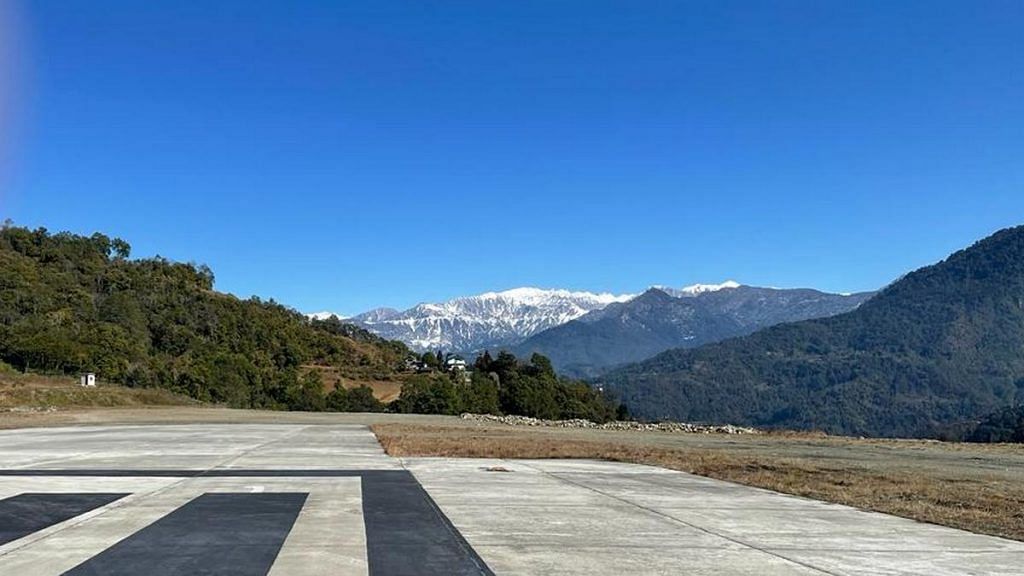
Largely due to land acquisition problems, however, the crucial connectivity project was not able to take off for nearly a decade. PM Modi inaugurated the Rs 533-crore airport in September 2018.
5. Eastern & Western Peripheral Expressway
The 135-km long Eastern Peripheral Expressway (EPE) was approved in 2006 to decongest Delhi roads by providing an alternate route for traffic not bound for the national capital. It saw several twists and turns before it was finally completed in 2018.
The Rs 2,699 crore project is one half of the 271-km long peripheral ring road around Delhi. The other half of the ring road — the Western Peripheral Expressway — implemented by the Haryana government was in the making for nine years. It was also completed and inaugurated in November 2018.
6. Bogibeel Bridge
Connecting Assam’s Dibrugarh with Dhemaji, which is located close to the Arunachal border, India’s longest rail bridge was inaugurated on 25 December, 2018, more than two decades after it was sanctioned in 1997. That year, when then PM H.D. Deve Gowda laid its foundation stone, the project cost was estimated at Rs 1,767 crore.
Work on the bridge proceeded at a snail’s pace. It started in 2002, when Atal Bihari Vajpayee was the prime minister, but stalled after 2004, the year when the UPA first came to power. Touted as a lifeline for northeast India, Bogibeel instead became known as a “bridge to nowhere”, with the numerous delays attributed in part to red-tapism.
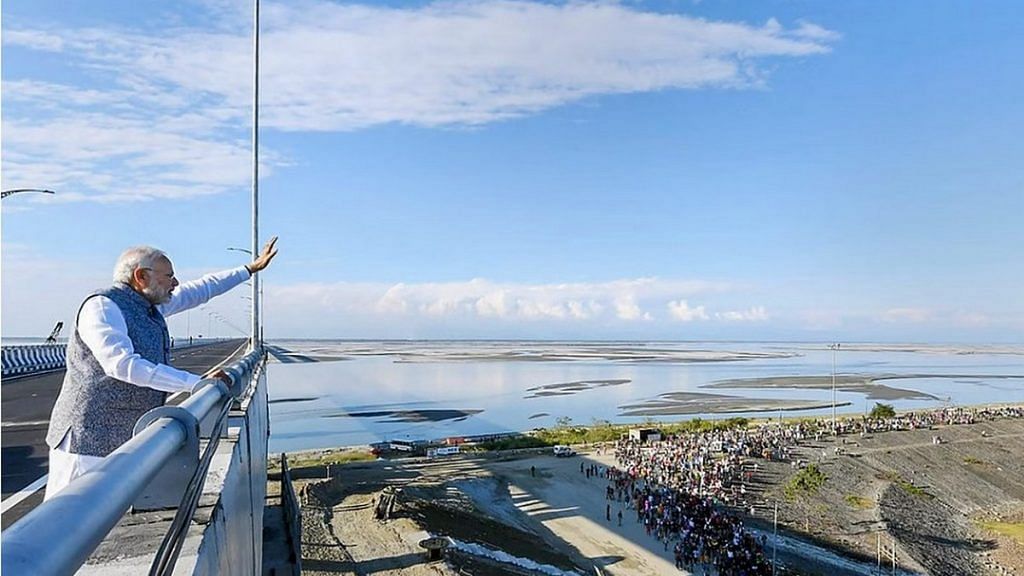
Construction started in earnest only in 2014, by which time the design, scope, and cost of the work had changed.
The 4.94-km-long bridge has reduced train travel time between Delhi and Dibrugarh by three hours and is also of strategic importance to the Army since it facilitates easier and quicker movement of troops to Arunachal.
7. Kashmir rail-link project
The 326-km Jammu-Udhampur-Srinagar-Baramulla rail link was first approved in 1995 and was expected to be completed by 2002 at an estimated cost of Rs 2,500 crore.
But the crucial connectivity project that linked Kashmir to the rest of India saw several delays by successive governments, with the difficult topography of the region cited as a major blocker.
The Atal Bihari Vajpayee government declared it a national project in 2002 and fixed 2007 as its new completion date, but not much moved on the ground.
Cut to 2022. About two-thirds of the rail link — between Baramulla-Banihal and Jammu-Udhampur-Katra — is operational. The last phase linking Katra to Banihal is expected to be completed in 2023. The highest arch railway bridge in the world is coming up in the Katra-Banihal section over the Chenab River.
8. Vizhinjam Port
Until early this month, Kerala’s Vizhinjam Port witnessed vigorous protests and counter-protests, but the agitation has been called off, at least for now and work has resumed.
Slated to become India’s first container transshipment hub, and thus to play a crucial role in global supply chains, the project currently being built by the Adani Group has been in the pipeline for several decades.
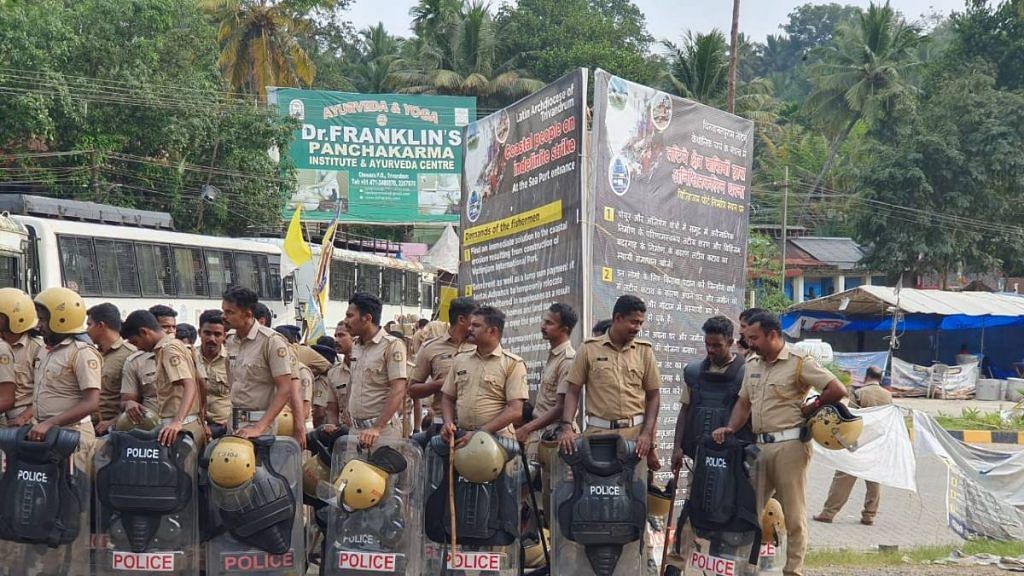
The plan to develop the port first came up in 1991, but protests from the residents ensured that not much happened in the intervening years.
In 2015, the project kicked into gear again and the contract to build it was signed under the state’s then Oommen Chandy-led United Democratic Front (UDF) government. The project has overshot its 2019 deadline, but with the protests simmering down, it is now anticipated that construction will be completed by September 2023.
9. Jewar Airport
The plan to build the Noida International Airport at Jewar was first mooted in 2001 when defence minister Rajnath Singh was CM of Uttar Pradesh.
From that point on, though, it was ensnared not only in land acquisition tangles, but political tussles between different dispensations helming the state and central governments
The UPA government put the project on the backburner after GMR Group, the Delhi airport operator, raised an objection citing its proximity to the capital’s airport.
The airport project, estimated to cost Rs 30,000 crore, was finally revived only after the NDA government came to power in 2014. The first phase of construction, estimated to cost Rs 4,599 crore, is expected to be completed by January 2024.
10. Bangalore-Chennai Expressway
First announced in 2011, the 262-km Bangalore-Chennai Expressway is only now going somewhere, with work starting earlier this year and PM Modi laying the foundation stone in May.
The Rs 12,500-crore greenfield project, which is being built by the NHAI, is expected to be completed by March 2024.
It will connect Hoskote in Karnataka to Sriperumbudur in Tamil Nadu and will pass through three states — Karnataka, Andhra Pradesh, and Tamil Nadu. It will reduce the travel time between Bengaluru and Chennai to under three hours from the existing seven hours or so.
(Edited by Asavari Singh)
Also read: Pier by pier, girder by girder, how bullet train project’s 348-km Gujarat leg is gathering speed


